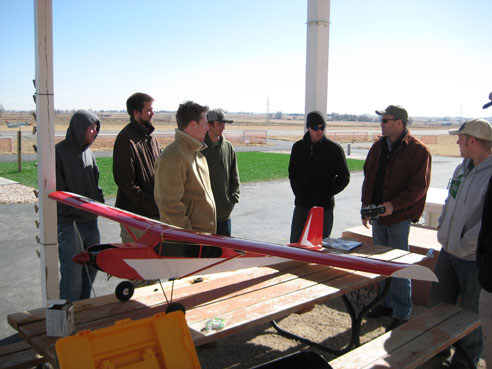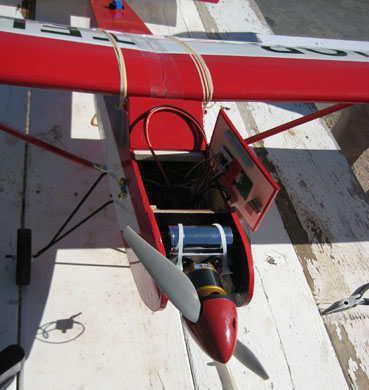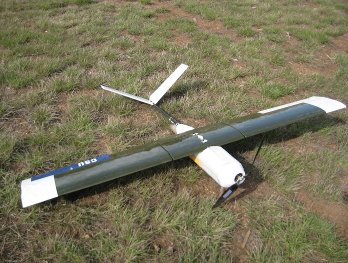Difference between revisions of "User:CSU-FCUAV"
| (25 intermediate revisions by the same user not shown) | |||
| Line 1: | Line 1: | ||
== CSU - Long Endurance Flight Team == | |||
[[Image:CSUFCUAV.jpg]] | |||
The long endurance unmanned aerial vehicle (UAV) has significant value as a low-cost, autonomous reconnaissance and remote sensing platform for research, commercial and military missions. Fuel cell powerplants are of interest in this application because of the potential to construct powerplants of high specific energy, low noise, low thermal signature, and improved environmental compatibility. | |||
Because of these performance advantages, fuel cells have recently found their first aviation applications as powerplants for small-scale long-endurance and long-range UAVs. | |||
The increasing interest in practical fuel cell powered UAVs motivated research into design methods for fuel cell powered aircraft. The purposes of the design studies are 1) to characterize the design tradeoffs and optimal configurations of aviation-specific fuel cell powerplants, 2) to compare the performance of fuel cell aircraft to conventional aircraft, and 3) to function as a preliminary design tool in a development process for a fuel cell UAV. | |||
== Hobby Lobby Senior Telemaster ARF Autopilot/Sensor Mule== | |||
[[Image:CSUTelemaster.JPG]] | |||
This aircraft was our first to be integrated with the Paparazzi Autopilot. It is now used as a test platform for new flight plans, equipment, and sensors. Recently we were able to repeatedly runway land this aircraft under autopilot control. Soon we will test autonomous take off. Current work includes the development of a direct IR replacement IMU to be used in other aircraft. | |||
'''Specs:''' | |||
Airframe: Hobby Lobyy Senior Telemaster ARF | |||
RX: Futaba R6014FS to PPZUAV PPM Encoder | |||
Autopilot: Tiny 2.11 LEA-5H from PPZUAV | |||
Link: XBee Pro 2.4 GHz | |||
IR: PPZUAV IRV and IRH Sensors | |||
Extras: Spartan DS760 AVCS Gyro | |||
'''Associated Files:''' | |||
Airframe: [[CSU_Telemaster]] | |||
Heading Hold Gyro: [[CSU_SpartanDS760]] | |||
'''Media:''' | |||
[http://www.youtube.com/watch?v=vSKq7RW4u0M Flight 1 Video] | |||
[http://www.youtube.com/watch?v=4DRsjjN2jhI Flight 2 Video] | |||
[http://www.youtube.com/watch?v=byjTX09vLNI Flight 3 Video] | |||
== Long Endurance Hand Launchable Man Packable UAV == | |||
[[Image:CSU_MPUAV.jpg]] | |||
This aircraft was designed with the help of a Powertrain Design and Optimization Tool developed by Colorado State University to provide enough thrust for hand launchability and high efficiency cruise. Initial flight and hardware in the loop simulation suggest the aircraft is capable of greater than three hours endurance. | |||
Current work on this aircraft includes building a better, stronger wing to handle the overspeed conditions experienced in test flights as well as a final long endurance flight. | |||
'''Specs:''' | |||
Status: Rebuild | |||
Airframe: CSU MPUAV | |||
RX: Modified Futaba R617FS | |||
Autopilot: Tiny 2.11 LEA-5H from PPZUAV | |||
Link: XBee Pro 2.4 GHz | |||
IR: FMA IRV and IRH Sensors | |||
'''Associated Files:''' | |||
Airframe: [[CSU_Telemaster]] | |||
'''Media:''' | |||
[http://www.youtube.com/watch?v=mJHMrWltcy4 First Hand Launch Attempt] | |||
[http://www.youtube.com/watch?v=FjzURBxRLws Second Hand Launch Attempt] | |||
[http://www.youtube.com/watch?v=pxJ1bWzmUkA Second Hand Launch Attempt Crash Feed] | |||
[http://www.youtube.com/watch?v=c2yUffSuJ60 Crash Aftermath] | |||
[http://www.youtube.com/watch?v=-mbEqAVP2-E Maiden Flight] | |||
== Vertical Take-Off and Landing UAV == | |||
After going to the RC field a few times we decided one project we would like to attempt is use an IMU to provide sensor input for a hovering fixed wing aircraft to accomplish vertical take-off and landing. Currently, the ARF has been assembled and tested. The next step is the development of the IMU for IR sensor replacement and a landing tripod attached to the aircraft. Once flight testing has been completed with the landing tripod, a Paparazzi autopilot will be installed. | |||
Status: Build | |||
Airframe: [http://www.hangar-9.com/Products/Default.aspx?ProdID=HAN4210 Hangar 9 Twist 60] | |||
RX: Futaba R6014FS to PPZUAV PPM Encoder | |||
== Contact Information == | |||
Dr. Thomas H. Bradley | |||
Mechanical Engineering | |||
Colorado State University | |||
E: [mailto:thomas.bradley@colostate.edu thomas.bradley@colostate.edu] | |||
Latest revision as of 08:45, 3 August 2010
CSU - Long Endurance Flight Team
The long endurance unmanned aerial vehicle (UAV) has significant value as a low-cost, autonomous reconnaissance and remote sensing platform for research, commercial and military missions. Fuel cell powerplants are of interest in this application because of the potential to construct powerplants of high specific energy, low noise, low thermal signature, and improved environmental compatibility.
Because of these performance advantages, fuel cells have recently found their first aviation applications as powerplants for small-scale long-endurance and long-range UAVs.
The increasing interest in practical fuel cell powered UAVs motivated research into design methods for fuel cell powered aircraft. The purposes of the design studies are 1) to characterize the design tradeoffs and optimal configurations of aviation-specific fuel cell powerplants, 2) to compare the performance of fuel cell aircraft to conventional aircraft, and 3) to function as a preliminary design tool in a development process for a fuel cell UAV.
Hobby Lobby Senior Telemaster ARF Autopilot/Sensor Mule
This aircraft was our first to be integrated with the Paparazzi Autopilot. It is now used as a test platform for new flight plans, equipment, and sensors. Recently we were able to repeatedly runway land this aircraft under autopilot control. Soon we will test autonomous take off. Current work includes the development of a direct IR replacement IMU to be used in other aircraft.
Specs:
Airframe: Hobby Lobyy Senior Telemaster ARF
RX: Futaba R6014FS to PPZUAV PPM Encoder
Autopilot: Tiny 2.11 LEA-5H from PPZUAV
Link: XBee Pro 2.4 GHz
IR: PPZUAV IRV and IRH Sensors
Extras: Spartan DS760 AVCS Gyro
Associated Files:
Airframe: CSU_Telemaster
Heading Hold Gyro: CSU_SpartanDS760
Media:
Long Endurance Hand Launchable Man Packable UAV
This aircraft was designed with the help of a Powertrain Design and Optimization Tool developed by Colorado State University to provide enough thrust for hand launchability and high efficiency cruise. Initial flight and hardware in the loop simulation suggest the aircraft is capable of greater than three hours endurance.
Current work on this aircraft includes building a better, stronger wing to handle the overspeed conditions experienced in test flights as well as a final long endurance flight.
Specs:
Status: Rebuild
Airframe: CSU MPUAV
RX: Modified Futaba R617FS
Autopilot: Tiny 2.11 LEA-5H from PPZUAV
Link: XBee Pro 2.4 GHz
IR: FMA IRV and IRH Sensors
Associated Files:
Airframe: CSU_Telemaster
Media:
Second Hand Launch Attempt Crash Feed
Vertical Take-Off and Landing UAV
After going to the RC field a few times we decided one project we would like to attempt is use an IMU to provide sensor input for a hovering fixed wing aircraft to accomplish vertical take-off and landing. Currently, the ARF has been assembled and tested. The next step is the development of the IMU for IR sensor replacement and a landing tripod attached to the aircraft. Once flight testing has been completed with the landing tripod, a Paparazzi autopilot will be installed.
Status: Build
Airframe: Hangar 9 Twist 60
RX: Futaba R6014FS to PPZUAV PPM Encoder
Contact Information
Dr. Thomas H. Bradley
Mechanical Engineering
Colorado State University


